Impact of HRM on Healthcare Changes and Trends: An Analysis
VerifiedAdded on 2022/11/25
|5
|1493
|276
Essay
AI Summary
This essay provides an in-depth analysis of the transformations within the healthcare industry over the past five to ten years, with a specific focus on the pivotal role of Human Resource Management (HRM). The essay commences by detailing the significant changes observed, including technological advancements, shifts in organizational structures, modifications in healthcare policies like the Affordable Care Act (ACA), modern payment methods, and improvements in patient care facilities. It then highlights digital technology as a major trend, emphasizing its impact on patient data management, diagnosis, and treatment processes, including telemedicine. The essay further examines the characteristics of an effective healthcare HR department, such as advocacy for patient care and compliance with healthcare guidelines, and the importance of HR metrics in measuring departmental effectiveness. The strategic significance of technological advancements and patient-centered approaches are discussed in terms of workforce productivity and overall growth. The essay concludes by summarizing the dynamic nature of the healthcare environment, emphasizing the need for healthcare organizations and professionals to embrace new trends and positive changes to achieve optimal performance and growth.
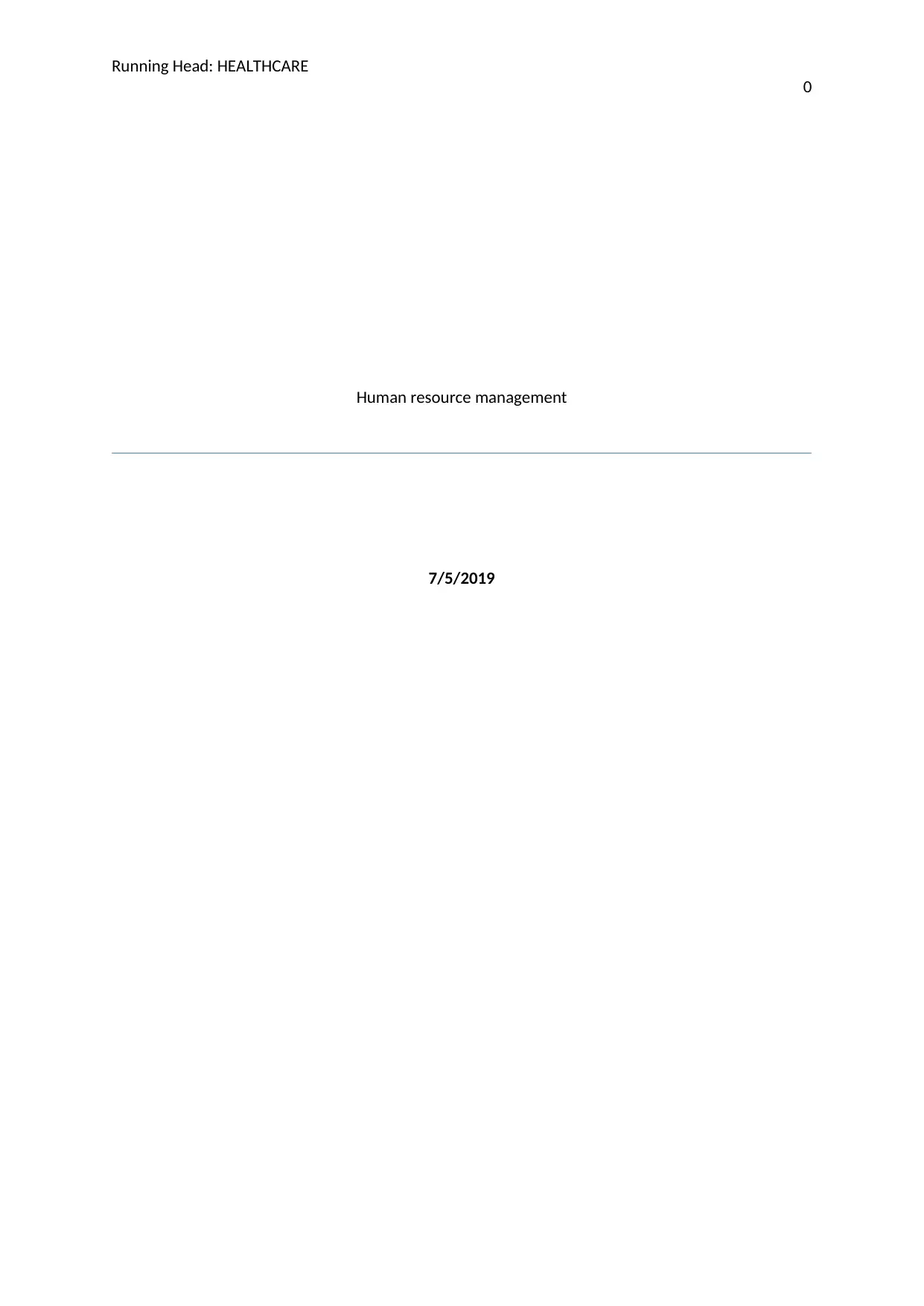
Running Head: HEALTHCARE
0
Human resource management
7/5/2019
0
Human resource management
7/5/2019
Paraphrase This Document
Need a fresh take? Get an instant paraphrase of this document with our AI Paraphraser
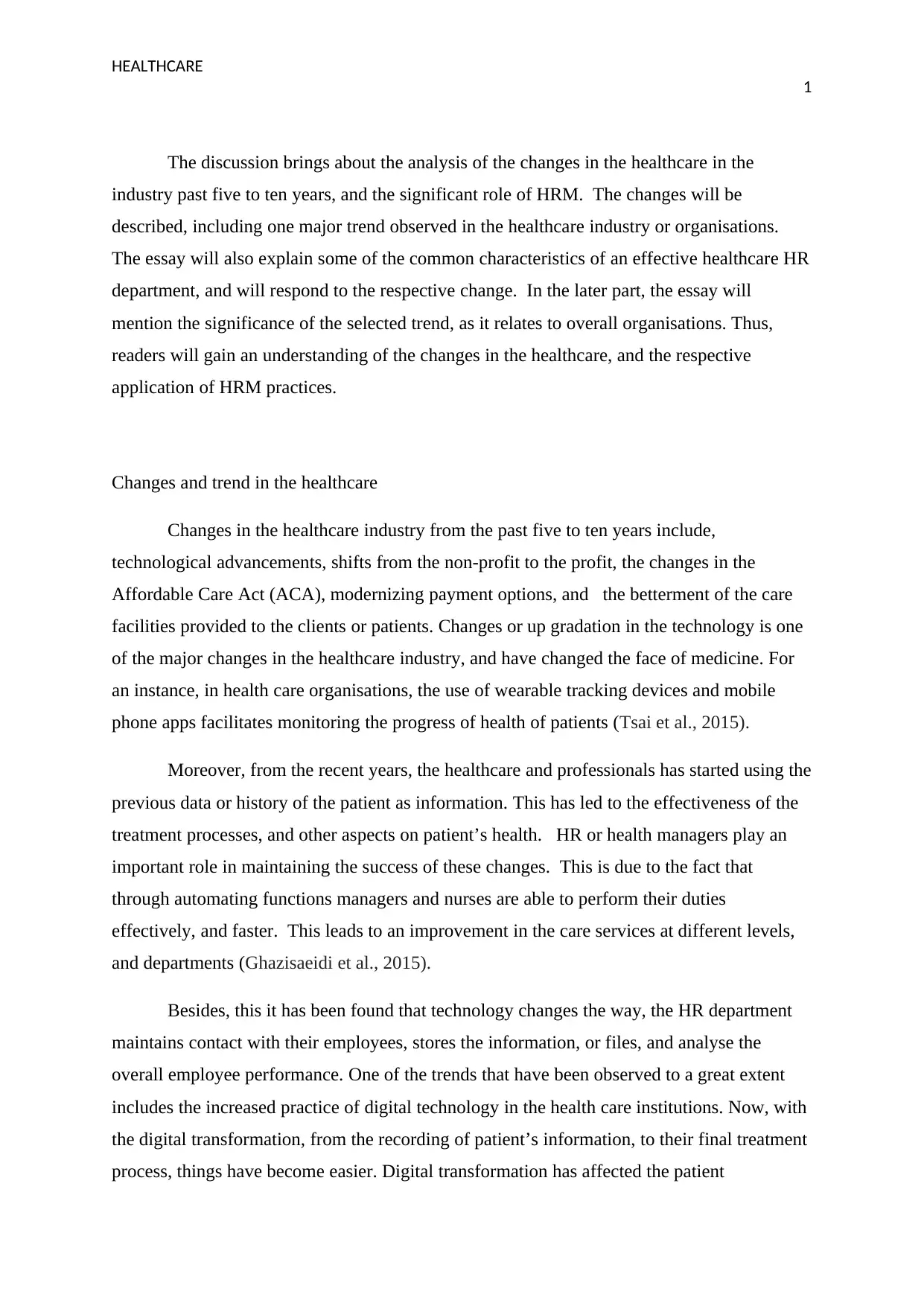
HEALTHCARE
1
The discussion brings about the analysis of the changes in the healthcare in the
industry past five to ten years, and the significant role of HRM. The changes will be
described, including one major trend observed in the healthcare industry or organisations.
The essay will also explain some of the common characteristics of an effective healthcare HR
department, and will respond to the respective change. In the later part, the essay will
mention the significance of the selected trend, as it relates to overall organisations. Thus,
readers will gain an understanding of the changes in the healthcare, and the respective
application of HRM practices.
Changes and trend in the healthcare
Changes in the healthcare industry from the past five to ten years include,
technological advancements, shifts from the non-profit to the profit, the changes in the
Affordable Care Act (ACA), modernizing payment options, and the betterment of the care
facilities provided to the clients or patients. Changes or up gradation in the technology is one
of the major changes in the healthcare industry, and have changed the face of medicine. For
an instance, in health care organisations, the use of wearable tracking devices and mobile
phone apps facilitates monitoring the progress of health of patients (Tsai et al., 2015).
Moreover, from the recent years, the healthcare and professionals has started using the
previous data or history of the patient as information. This has led to the effectiveness of the
treatment processes, and other aspects on patient’s health. HR or health managers play an
important role in maintaining the success of these changes. This is due to the fact that
through automating functions managers and nurses are able to perform their duties
effectively, and faster. This leads to an improvement in the care services at different levels,
and departments (Ghazisaeidi et al., 2015).
Besides, this it has been found that technology changes the way, the HR department
maintains contact with their employees, stores the information, or files, and analyse the
overall employee performance. One of the trends that have been observed to a great extent
includes the increased practice of digital technology in the health care institutions. Now, with
the digital transformation, from the recording of patient’s information, to their final treatment
process, things have become easier. Digital transformation has affected the patient
1
The discussion brings about the analysis of the changes in the healthcare in the
industry past five to ten years, and the significant role of HRM. The changes will be
described, including one major trend observed in the healthcare industry or organisations.
The essay will also explain some of the common characteristics of an effective healthcare HR
department, and will respond to the respective change. In the later part, the essay will
mention the significance of the selected trend, as it relates to overall organisations. Thus,
readers will gain an understanding of the changes in the healthcare, and the respective
application of HRM practices.
Changes and trend in the healthcare
Changes in the healthcare industry from the past five to ten years include,
technological advancements, shifts from the non-profit to the profit, the changes in the
Affordable Care Act (ACA), modernizing payment options, and the betterment of the care
facilities provided to the clients or patients. Changes or up gradation in the technology is one
of the major changes in the healthcare industry, and have changed the face of medicine. For
an instance, in health care organisations, the use of wearable tracking devices and mobile
phone apps facilitates monitoring the progress of health of patients (Tsai et al., 2015).
Moreover, from the recent years, the healthcare and professionals has started using the
previous data or history of the patient as information. This has led to the effectiveness of the
treatment processes, and other aspects on patient’s health. HR or health managers play an
important role in maintaining the success of these changes. This is due to the fact that
through automating functions managers and nurses are able to perform their duties
effectively, and faster. This leads to an improvement in the care services at different levels,
and departments (Ghazisaeidi et al., 2015).
Besides, this it has been found that technology changes the way, the HR department
maintains contact with their employees, stores the information, or files, and analyse the
overall employee performance. One of the trends that have been observed to a great extent
includes the increased practice of digital technology in the health care institutions. Now, with
the digital transformation, from the recording of patient’s information, to their final treatment
process, things have become easier. Digital transformation has affected the patient
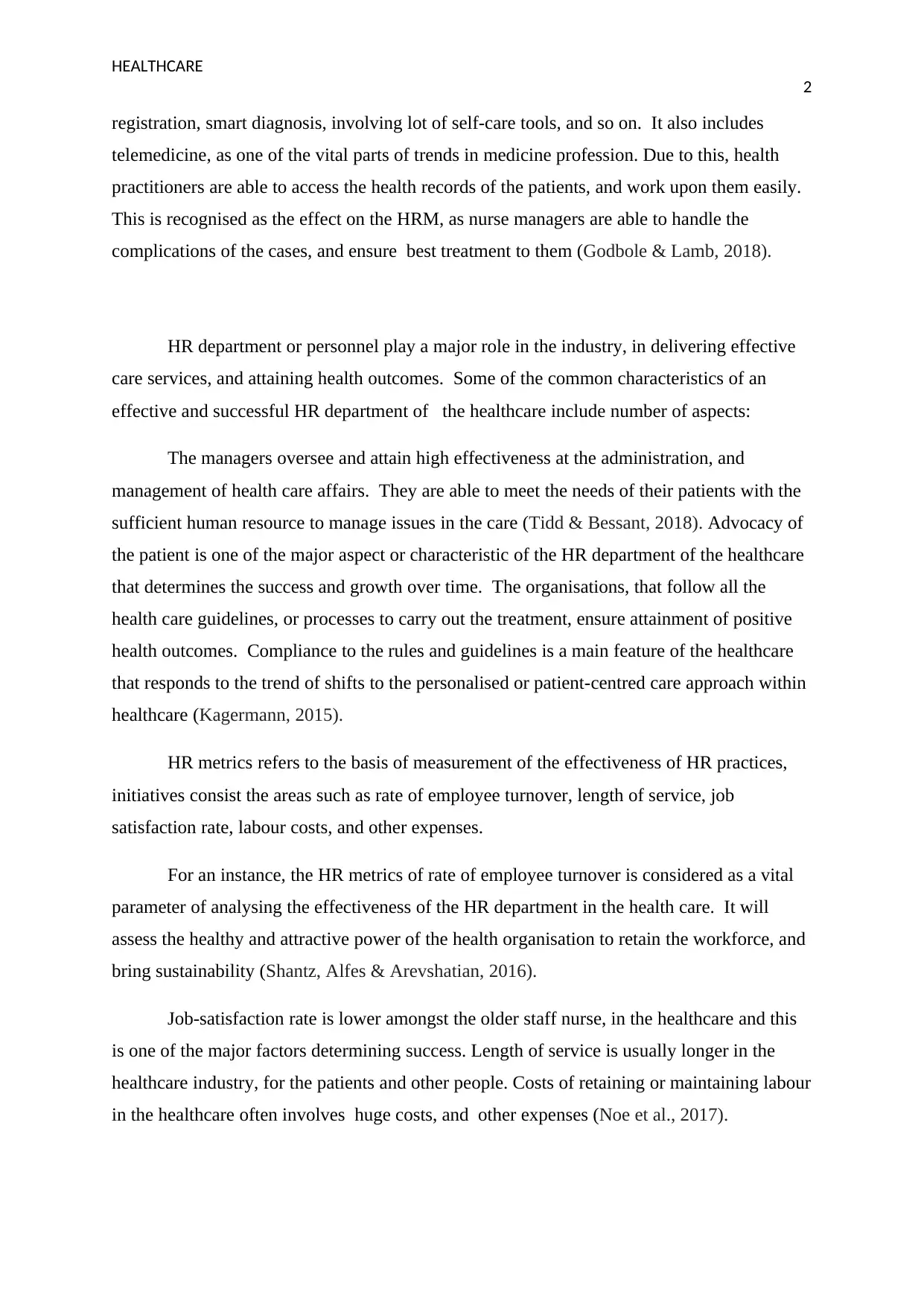
HEALTHCARE
2
registration, smart diagnosis, involving lot of self-care tools, and so on. It also includes
telemedicine, as one of the vital parts of trends in medicine profession. Due to this, health
practitioners are able to access the health records of the patients, and work upon them easily.
This is recognised as the effect on the HRM, as nurse managers are able to handle the
complications of the cases, and ensure best treatment to them (Godbole & Lamb, 2018).
HR department or personnel play a major role in the industry, in delivering effective
care services, and attaining health outcomes. Some of the common characteristics of an
effective and successful HR department of the healthcare include number of aspects:
The managers oversee and attain high effectiveness at the administration, and
management of health care affairs. They are able to meet the needs of their patients with the
sufficient human resource to manage issues in the care (Tidd & Bessant, 2018). Advocacy of
the patient is one of the major aspect or characteristic of the HR department of the healthcare
that determines the success and growth over time. The organisations, that follow all the
health care guidelines, or processes to carry out the treatment, ensure attainment of positive
health outcomes. Compliance to the rules and guidelines is a main feature of the healthcare
that responds to the trend of shifts to the personalised or patient-centred care approach within
healthcare (Kagermann, 2015).
HR metrics refers to the basis of measurement of the effectiveness of HR practices,
initiatives consist the areas such as rate of employee turnover, length of service, job
satisfaction rate, labour costs, and other expenses.
For an instance, the HR metrics of rate of employee turnover is considered as a vital
parameter of analysing the effectiveness of the HR department in the health care. It will
assess the healthy and attractive power of the health organisation to retain the workforce, and
bring sustainability (Shantz, Alfes & Arevshatian, 2016).
Job-satisfaction rate is lower amongst the older staff nurse, in the healthcare and this
is one of the major factors determining success. Length of service is usually longer in the
healthcare industry, for the patients and other people. Costs of retaining or maintaining labour
in the healthcare often involves huge costs, and other expenses (Noe et al., 2017).
2
registration, smart diagnosis, involving lot of self-care tools, and so on. It also includes
telemedicine, as one of the vital parts of trends in medicine profession. Due to this, health
practitioners are able to access the health records of the patients, and work upon them easily.
This is recognised as the effect on the HRM, as nurse managers are able to handle the
complications of the cases, and ensure best treatment to them (Godbole & Lamb, 2018).
HR department or personnel play a major role in the industry, in delivering effective
care services, and attaining health outcomes. Some of the common characteristics of an
effective and successful HR department of the healthcare include number of aspects:
The managers oversee and attain high effectiveness at the administration, and
management of health care affairs. They are able to meet the needs of their patients with the
sufficient human resource to manage issues in the care (Tidd & Bessant, 2018). Advocacy of
the patient is one of the major aspect or characteristic of the HR department of the healthcare
that determines the success and growth over time. The organisations, that follow all the
health care guidelines, or processes to carry out the treatment, ensure attainment of positive
health outcomes. Compliance to the rules and guidelines is a main feature of the healthcare
that responds to the trend of shifts to the personalised or patient-centred care approach within
healthcare (Kagermann, 2015).
HR metrics refers to the basis of measurement of the effectiveness of HR practices,
initiatives consist the areas such as rate of employee turnover, length of service, job
satisfaction rate, labour costs, and other expenses.
For an instance, the HR metrics of rate of employee turnover is considered as a vital
parameter of analysing the effectiveness of the HR department in the health care. It will
assess the healthy and attractive power of the health organisation to retain the workforce, and
bring sustainability (Shantz, Alfes & Arevshatian, 2016).
Job-satisfaction rate is lower amongst the older staff nurse, in the healthcare and this
is one of the major factors determining success. Length of service is usually longer in the
healthcare industry, for the patients and other people. Costs of retaining or maintaining labour
in the healthcare often involves huge costs, and other expenses (Noe et al., 2017).
⊘ This is a preview!⊘
Do you want full access?
Subscribe today to unlock all pages.

Trusted by 1+ million students worldwide
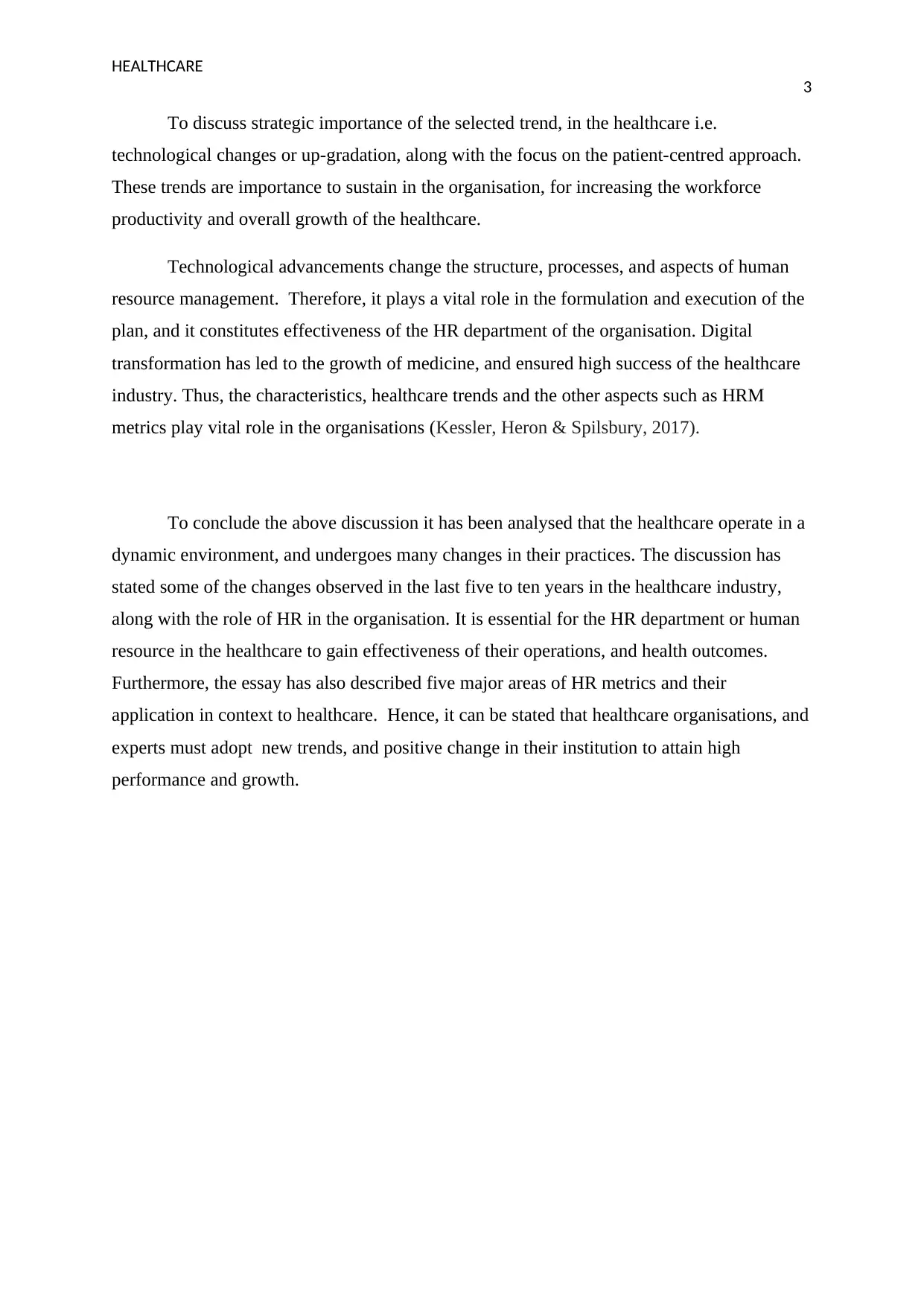
HEALTHCARE
3
To discuss strategic importance of the selected trend, in the healthcare i.e.
technological changes or up-gradation, along with the focus on the patient-centred approach.
These trends are importance to sustain in the organisation, for increasing the workforce
productivity and overall growth of the healthcare.
Technological advancements change the structure, processes, and aspects of human
resource management. Therefore, it plays a vital role in the formulation and execution of the
plan, and it constitutes effectiveness of the HR department of the organisation. Digital
transformation has led to the growth of medicine, and ensured high success of the healthcare
industry. Thus, the characteristics, healthcare trends and the other aspects such as HRM
metrics play vital role in the organisations (Kessler, Heron & Spilsbury, 2017).
To conclude the above discussion it has been analysed that the healthcare operate in a
dynamic environment, and undergoes many changes in their practices. The discussion has
stated some of the changes observed in the last five to ten years in the healthcare industry,
along with the role of HR in the organisation. It is essential for the HR department or human
resource in the healthcare to gain effectiveness of their operations, and health outcomes.
Furthermore, the essay has also described five major areas of HR metrics and their
application in context to healthcare. Hence, it can be stated that healthcare organisations, and
experts must adopt new trends, and positive change in their institution to attain high
performance and growth.
3
To discuss strategic importance of the selected trend, in the healthcare i.e.
technological changes or up-gradation, along with the focus on the patient-centred approach.
These trends are importance to sustain in the organisation, for increasing the workforce
productivity and overall growth of the healthcare.
Technological advancements change the structure, processes, and aspects of human
resource management. Therefore, it plays a vital role in the formulation and execution of the
plan, and it constitutes effectiveness of the HR department of the organisation. Digital
transformation has led to the growth of medicine, and ensured high success of the healthcare
industry. Thus, the characteristics, healthcare trends and the other aspects such as HRM
metrics play vital role in the organisations (Kessler, Heron & Spilsbury, 2017).
To conclude the above discussion it has been analysed that the healthcare operate in a
dynamic environment, and undergoes many changes in their practices. The discussion has
stated some of the changes observed in the last five to ten years in the healthcare industry,
along with the role of HR in the organisation. It is essential for the HR department or human
resource in the healthcare to gain effectiveness of their operations, and health outcomes.
Furthermore, the essay has also described five major areas of HR metrics and their
application in context to healthcare. Hence, it can be stated that healthcare organisations, and
experts must adopt new trends, and positive change in their institution to attain high
performance and growth.
Paraphrase This Document
Need a fresh take? Get an instant paraphrase of this document with our AI Paraphraser
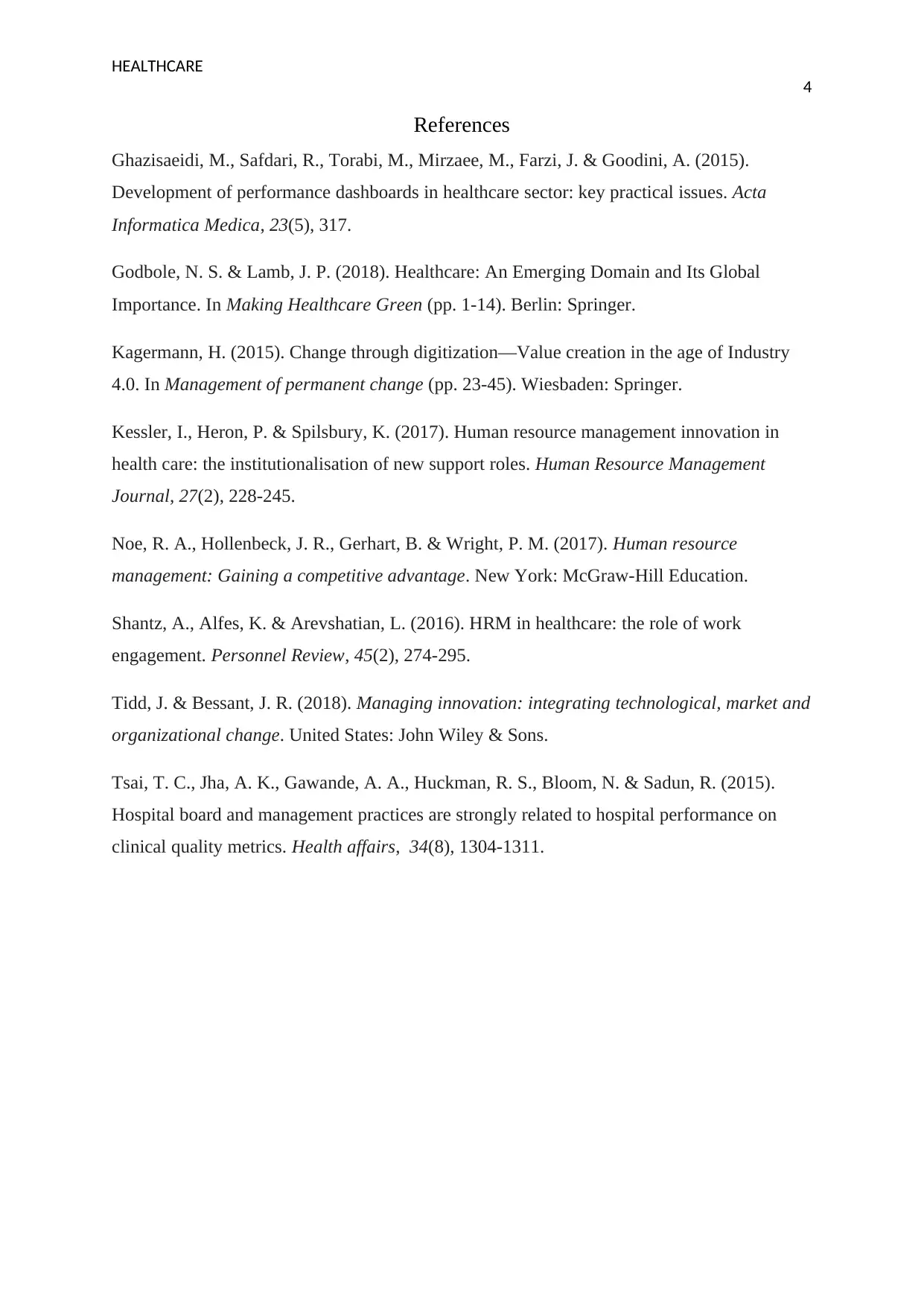
HEALTHCARE
4
References
Ghazisaeidi, M., Safdari, R., Torabi, M., Mirzaee, M., Farzi, J. & Goodini, A. (2015).
Development of performance dashboards in healthcare sector: key practical issues. Acta
Informatica Medica, 23(5), 317.
Godbole, N. S. & Lamb, J. P. (2018). Healthcare: An Emerging Domain and Its Global
Importance. In Making Healthcare Green (pp. 1-14). Berlin: Springer.
Kagermann, H. (2015). Change through digitization—Value creation in the age of Industry
4.0. In Management of permanent change (pp. 23-45). Wiesbaden: Springer.
Kessler, I., Heron, P. & Spilsbury, K. (2017). Human resource management innovation in
health care: the institutionalisation of new support roles. Human Resource Management
Journal, 27(2), 228-245.
Noe, R. A., Hollenbeck, J. R., Gerhart, B. & Wright, P. M. (2017). Human resource
management: Gaining a competitive advantage. New York: McGraw-Hill Education.
Shantz, A., Alfes, K. & Arevshatian, L. (2016). HRM in healthcare: the role of work
engagement. Personnel Review, 45(2), 274-295.
Tidd, J. & Bessant, J. R. (2018). Managing innovation: integrating technological, market and
organizational change. United States: John Wiley & Sons.
Tsai, T. C., Jha, A. K., Gawande, A. A., Huckman, R. S., Bloom, N. & Sadun, R. (2015).
Hospital board and management practices are strongly related to hospital performance on
clinical quality metrics. Health affairs, 34(8), 1304-1311.
4
References
Ghazisaeidi, M., Safdari, R., Torabi, M., Mirzaee, M., Farzi, J. & Goodini, A. (2015).
Development of performance dashboards in healthcare sector: key practical issues. Acta
Informatica Medica, 23(5), 317.
Godbole, N. S. & Lamb, J. P. (2018). Healthcare: An Emerging Domain and Its Global
Importance. In Making Healthcare Green (pp. 1-14). Berlin: Springer.
Kagermann, H. (2015). Change through digitization—Value creation in the age of Industry
4.0. In Management of permanent change (pp. 23-45). Wiesbaden: Springer.
Kessler, I., Heron, P. & Spilsbury, K. (2017). Human resource management innovation in
health care: the institutionalisation of new support roles. Human Resource Management
Journal, 27(2), 228-245.
Noe, R. A., Hollenbeck, J. R., Gerhart, B. & Wright, P. M. (2017). Human resource
management: Gaining a competitive advantage. New York: McGraw-Hill Education.
Shantz, A., Alfes, K. & Arevshatian, L. (2016). HRM in healthcare: the role of work
engagement. Personnel Review, 45(2), 274-295.
Tidd, J. & Bessant, J. R. (2018). Managing innovation: integrating technological, market and
organizational change. United States: John Wiley & Sons.
Tsai, T. C., Jha, A. K., Gawande, A. A., Huckman, R. S., Bloom, N. & Sadun, R. (2015).
Hospital board and management practices are strongly related to hospital performance on
clinical quality metrics. Health affairs, 34(8), 1304-1311.
1 out of 5
Related Documents
Your All-in-One AI-Powered Toolkit for Academic Success.
+13062052269
info@desklib.com
Available 24*7 on WhatsApp / Email
![[object Object]](/_next/static/media/star-bottom.7253800d.svg)
Unlock your academic potential
Copyright © 2020–2025 A2Z Services. All Rights Reserved. Developed and managed by ZUCOL.




